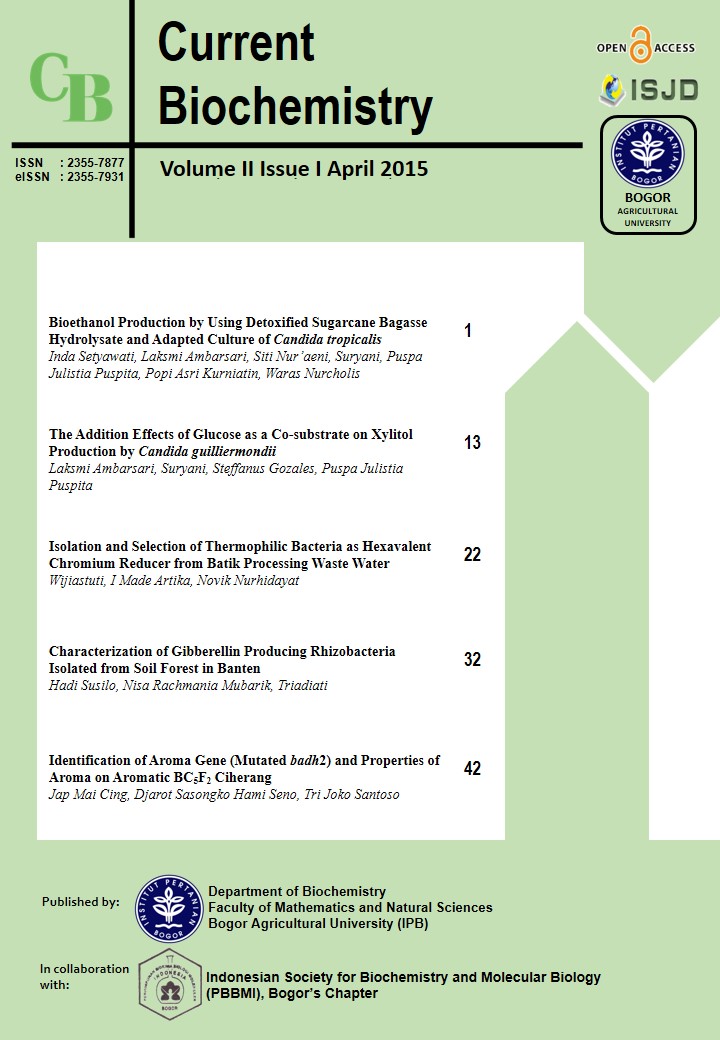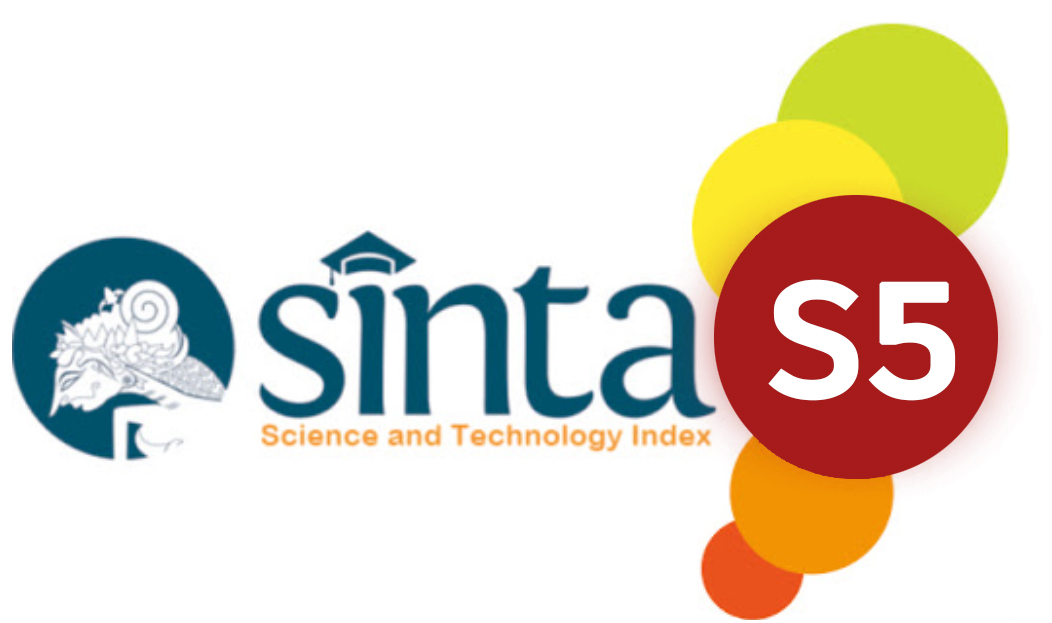Bioethanol Production by Using Detoxified Sugarcane Bagasse Hydrolysate and Adapted Culture of <i>Candida tropicalis</i>
Abstract
Ethanol is considered as the most promising alternative fuel, since it can be produced from a variety of agriculturally-based renewable materials, such as sugarcane bagasse. Lignocellulose as a major component of sugarcane bagasse is considered as an attractive renewable resource for ethanol production due to its great availability and relatively low cost. The major problem of lignocellulose is caused by its need for treatment to be hydrolyzed to simple sugar before being used for bioethanol production. However, pretreatment using acid as hydrolyzing agent creates some inhibitor compounds that reduce ethanol production because these compounds are potential fermentation inhibitors and affect the growth rate of the yeast. Reduction of these by-products requires a conditioning (detoxification and culture starter adaptation). Thus, the aim of this study was to evaluate bioethanol production by fermentation with and without detoxified sugarcane bagasse acid hydrolysate using adapted and non-adapted culture of C. tropicalis. According to this study, the highest ethanol amount was obtained about 0.43 % (v/v) with an ethanol yield of 2.51 % and theoretical yield of 4.92 % by fermentation of sugarcane bagasse hydrolysate with detoxification using the adapted strain of C. tropicalis at 72 hours fermentation time. Furthermore, the addition of 3 % glucose as co-substrate on detoxified-hydrolysate media only achieved the highest ethanol concentration 0.21 % after 24 hours fermentation with the ethanol yield 0.69 % and theoretical ethanol yield 1.35 %, thus it can be concluded that the addition of glucose could not increase the ethanol production.
References
Alves, L.E., M.G.A. Felipe, S.S. Silva, A.MR. Prata. 199 8. Pretreatment of sugarcane bagasse hemicellulose hydrolysate for xylitol production by Candida guilliermondii. Appl. Biochem. Biotechnol. 70/72: 89-98.
Carlo N Hamelinck, Geertje van Hooijdonk, and Andre´ PC Faaij. 2005. Ethanol from lignocellulosic biomass: techno-economic performance in short-, middle- and long-term. Biomass and Bioenergy 28: 384–410.
Dien BS., Nicholas NN PJ, and Bothast RJ. 2000. Development of new ethanologenic Eschericia coli strains for fermentation of lignocellulosic biomass. Appl. Biochem. Biotechnol. 84: 181-196.
Huang CF, Lin TH, Guo GL, and Hwang WS. 2009. Enhanced ethanol production by fermentation of rice straw hydrolysate without detoxification using a newly adapted strain of Pichia stipitis. Bioresource Technology. 100: 3914-3920.
Lynd L.R., Cushaman J. H., Nichols R. J., and Wyman C. E. 199 1. Fuel ethanol from cellulosic biomass. Science. 251:1318.
Mancilha IM and Karim MN. 2003. Evaluation of ion exchange resins for removal of inhibitory compound from corn stover hydrolysate for xylitol fermentation. Biotechnol Prog. 19: 1837-1841.
Martín J. F. G., M. Cuevas., Vicente, B and Sebastian, S. 2010. Ethanol production from olive prunings by autohydrolysis and fermentation with Candida tropicalis.Renewable Energy, 35: 1602-1608.
Martin C and Jonsson LJ. 2003. Comparison of the resistance of industrial and laboratory strains of Saccharomyces and Zygosaccharomyces to lignocellulosic-derived fermentation inhibitors. Enzyme Microbial Technol. 32: 386-395.
Miller, GL. 1959. Use of Dinitrosalicylic Acid Reagent for Determination of Reducing Sugar. Anal. Chem. 31 (3): 300-310.
Pandey, A., C.R. Soccol, P. Nigam, and V.T. Soccol. 2006. Biotechnologycal Potential of Agro-industrial Residues. I. Sugarcane Bagasse. Bioresour.Techno., 74: 69-80.
Papong, S. and Malakul, P., 2010.Life-cycle energy and environmental analysis of bioethanol production from Cassava in Thailand.Bioresour.Technol. 101: 112–118.
Posada, J.A., Patel, A.D., Roes, A., Blok, K., Faaij, A.P.C., and Patel, M.K., 2013. Potential of bioethanol as a chemical building block for biorefineries: preliminary sustainability assessment of 12 bioethanol-based products. Bioresour. Technol. 135: 490–499 .
Purwadi R. 2006. Continue ethanol production from diluted-acid hidrolizates, detoxification and fermentation strategy [Thesis of Doctoral]. Goteborg; Chemical and Biological Engineering. Chamers University of Technology.
Rao, R.S., Ch. P. Jyothi, R.S. Prakasham, P.N. Sarma, and L.V. Rao. 2006. Xylitol Production from Corn Fiber and Sugarcane Bagasse Hydrolysates by Candida tropicalis.Bioresour.Techno., 97: 974-1978.
Rivas B, Torre P, Domfinguez JM, Perego P, Converti A, and Parajo PC. 2003. Carbon material and bioenergestic balances for xylitol production from corncob by Debaryomyces hansenii. Biotechnol Prog. 19: 706-713.
Sanchez S, V Bravo, AJ Moya, E Castro, and F Camacho. 2004. Influence of temperature on fermentation of D-xylose by Pachysolen tannophilus to produce ethanol and xylitol. Process Biochemistry. 39: 673-679.
Sun Y and Cheng J. 2002. Hydrolysis of lignocellulosic material for ethanol production: a review. Bioresour Technol. 83:1–11.
Taherzadeh MJ. 1999 . Ethanol from lignocellulose: Physiological effects of inhibitors and fermentation strategies [PhD thesis]. Go¨ teborg Sweden: Chalmers University of Technology, Department of Chemical Reaction Engineering.
Voet Ester van der, Lou L, Huppes G, Hean HA. 2009. Allocation issue in LCA methodology: a case study of corn stover-based fuel ethanol. Life Cycle Assessment. 14: 520-539.













